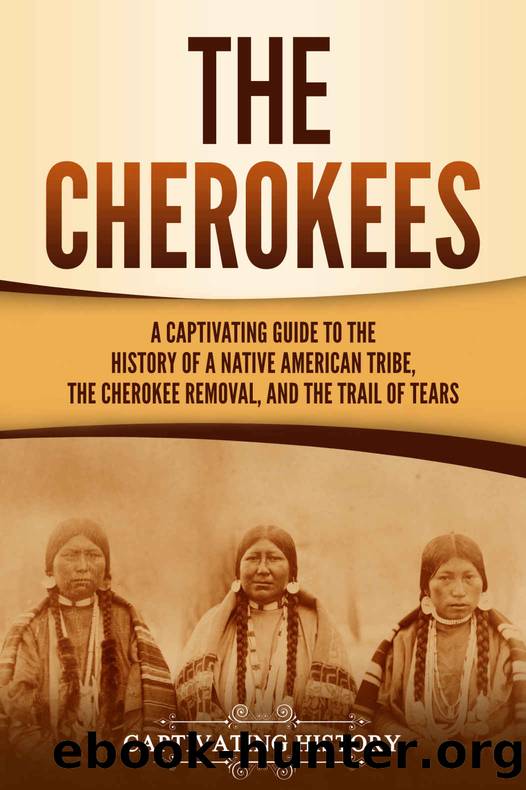The Cherokees: A Captivating Guide to the History of a Native American Tribe, the Cherokee Removal, and the Trail of Tears by History Captivating

Author:History, Captivating
Language: eng
Format: epub
Published: 2021-12-13T00:00:00+00:00
Chapter 8 â Unstable Times in Oklahoma
âI was hostile to the white manâ¦We preferred hunting to a life of idleness on our reservations. At times we did not get enough to eat and we were not allowed to hunt. All we wanted was peace and to be let alone. Soldiers cameâ¦in the winterâ¦and destroyed our villages. Then Long Hair (Custer) cameâ¦They said we massacred him, but he would have done the same to us. Our first impulse was to escapeâ¦but we were so hemmed in we had to fight. After that I lived in peace, but the government would not let me alone. I was no allowed to remain quiet. I was tired of fightingâ¦They tried to confine meâ¦and a soldier ran his bayonet into me. I have spoken.â
- Crazy Horse, Chief of the Sioux
Those who survived the Trail of Tears were welcomed into Oklahoma with not-so-welcome arms. The previous Cherokee settlers and the new ones faced discrepancies in tradition, rituals, and boundaries, as they were forced to live together once again. The other tribes that occupied that territory, including the Osage, also caused territorial conflicts. However, as can be seen later in the 19th and 20th centuries, this land, according to the federal government, was never theirs to begin with.
Chief John Ross of the Cherokee was determined to keep his people united and the nation strong and continue their traditional practices. Chief John Ross managed to band together not only the survivors from the Trail of Tears but also the Cherokee who were already there, commonly called the âOld Settlers.â Principal Chief Ross ratified the Cherokee Nationâs Constitution on September 6th, 1839. His efforts, along with those of several other Cherokee leaders and the community itself, allowed for a new building to house their Supreme Court, which was constructed in 1844. He even helped to establish and build their new capital city, Tahlequah. Chief John Ross didnât waste any time.
However, new problems soon arose. A storm was brewing in the United States, and the Cherokee were caught in the middle of it. Sectionalism was on the rise, and war soon broke out between the South and the North. Now known as the Civil War, this brother-against-brother violence was some of the bloodiest in the history of the nation.
Some of the wealthy Cherokee owned slaves. Similar to the South, only the elite few were able to own more than one or two enslaved persons. This part of Cherokee history is dark and unfortunate, just like the United States of Americaâs history of slavery in the South. Many of the enslaved in the Cherokee tribe were chattel slaves, and the Cherokee had the most slaves of all the Five Civilized Tribes. Although many argue that the Cherokee had a gentler form of slavery, their constitution decreed that enslaved people had no right to vote, could not drink alcohol, own property, or marry a Cherokee. Though these rules were not enforced well or very often, they still existed.
Their new home was in Oklahoma, where the Confederacy reigned supreme.
Download
This site does not store any files on its server. We only index and link to content provided by other sites. Please contact the content providers to delete copyright contents if any and email us, we'll remove relevant links or contents immediately.
Navigation and Map Reading by K Andrew(5111)
Spare by Prince Harry The Duke of Sussex(5073)
Tuesdays with Morrie by Mitch Albom(4694)
Cracking the GRE Premium Edition with 6 Practice Tests, 2015 (Graduate School Test Preparation) by Princeton Review(4225)
Machine Learning at Scale with H2O by Gregory Keys | David Whiting(4184)
Never by Ken Follett(3794)
Goodbye Paradise(3728)
What It Really Takes to Get Into Ivy League and Other Highly Selective Colleges by Hughes Chuck(3696)
Harry Potter and the Prisoner of Azkaban (Book 3) by J. K. Rowling(3304)
Fairy Tale by Stephen King(3220)
Pledged by Alexandra Robbins(3133)
Kick Ass in College: Highest Rated "How to Study in College" Book | 77 Ninja Study Skills Tips and Career Strategies | Motivational for College Students: A Guerrilla Guide to College Success by Fox Gunnar(3076)
A Dictionary of Sociology by Unknown(3031)
Sapiens and Homo Deus by Yuval Noah Harari(2987)
Reminders of Him: A Novel by Colleen Hoover(2952)
The Social Psychology of Inequality by Unknown(2940)
Graduate Admissions Essays, Fourth Edition: Write Your Way into the Graduate School of Your Choice (Graduate Admissions Essays: Write Your Way Into the) by Asher Donald(2876)
Will by Will Smith(2794)
Zero to Make by David Lang(2726)
